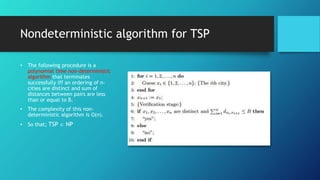Tsp is NP-Complete
- 1. TSP ’āÄ NP-Complete Emre Can Kucukoglu eckucukoglu@gmail.com 16.01.2016
- 2. Traveling Salesman Problem ŌĆó Given n cities ØæÉ1, ØæÉ2, ØæÉ3, ŌĆ” , ØæÉ Øæø and integer distances Øææ ØæÉ Øæ¢,ØæÉ ØæŚ between any two cities ØæÉØæ¢ ØæÄØæøØææ ØæÉØæŚ. ŌĆó TSP asks for the total distance of the shortest tour of the cities. ŌĆó Decision version of TSP asks if there is a tour with a total distance at most B, where B is an input.
- 3. TSP: formal description TSP = { <G, d, B> : G=(V, E) is a complete undirected graph, d is an edge cost function from VxVŌåÆZ+ Ōł¬ {0}, B Ōłł Z, G has a Hamiltonian cycle with cost Ōēż B }
- 4. TSP ’āÄ NP-Complete ? ŌĆó To prove that TSP ’āÄ NP-Complete, ŌĆó First, we must show that there exists a nondeterministic algorithm in polynomial time that solves TSP. ŌĆó TSP ’āÄ NP ŌĆó Then, we will reduce the undirected Hamiltonian cycle, which is a known NP-complete problem, to TSP: ŌĆó HAM-CYCLE Ōēż ØæØ TSP
- 5. Nondeterministic algorithm for TSP ŌĆó The following procedure is a polynomial time non-deterministic algorithm that terminates successfully iff an ordering of n- cities are distinct and sum of distances between pairs are less than or equal to B. ŌĆó The complexity of this non- deterministic algorithm is O(n). ŌĆó So that; TSP ’āÄ NP
- 6. Hamiltonian Circuit Problem ŌĆó Find a tour of a given unweighted graph that simply starts at one vertex and goes through all the other vertices and ends at the starting vertex. ŌĆó Note that the input graph G to a Hamiltonian Cycle problem need not be a complete graph connecting all vertices. ŌĆó Hamiltonian circuit is a known NP-Complete problem.
- 7. ŌĆó To transform Hamiltonian circuit/cycle problem to TSP, ŌĆó Create a graph GŌĆÖ = (V, EŌĆÖ) from Hamiltonian cycle instance G = (V, E), ŌĆó GŌĆÖ is a complete graph, ŌĆó Edges in EŌĆÖ also in E have an edge cost 0, ŌĆó All other edges in EŌĆÖ have an edge cost 1. HAM-CYCLE Ōēż ØæØ TSP
- 8. ŌĆó Take any instance G = (V, E) for the Hamiltonian cycle problem, ŌĆó Convert it into an instance GŌĆ▓=(V, EŌĆ▓ = V├ŚV, d), B = 0 of TSP, ŌĆó Øææ ØæÉ Øæ¢,ØæÉ ØæŚ = { 0 if edge (ØæÉØæ¢, ØæÉØæŚ) ’āÄ E, 1 otherwise } ŌĆó Time complexity of reduction is O(Øæø2) as there n(n-1)/2 edges on a complete graph. HAM-CYCLE Ōēż ØæØ TSP
- 9. ŌĆó Problem: Is there a TSP on GŌĆÖ with total edge cost = 0 ? ŌĆó If G has a Hamiltonian circuit, algorithm will return "yes" on input (GŌĆ▓, C), ŌĆó If there is no Hamiltonian circuit in G, algorithm will return "no" on input (GŌĆ▓, C). ŌĆó If GŌĆÖ has a cycle with cost = 0, every edge of that cycle has a cost = 0, thus G has a Hamiltonian cycle. ŌĆó If Hamiltonian cycle does not exist, then there is no simple cycle in G, that visits every vertex exactly once. Suppose that TSP has a ŌĆ£yesŌĆØ answer. Then, there is a cycle that visits every vertex once with total cost = 0. Since negative distance cost is not possible, every edges have cost = 0, which implies that these edges are in the Hamiltonian Circuit graph. It is a contradiction. HAM-CYCLE Ōēż ØæØ TSP
- 10. TSP ’āÄ NP-Complete ŌĆó It is well known that Hamiltonian Circuit is NP-Complete, every problem ├¤ in NP reduces to Hamiltonian Circuit in polynomial time. ŌĆó We have reduced Hamiltonian Circuit to TSP in polynomial time, it indicates that every problem ├¤ in NP reduces to TSP is polynomial time, since the sum of two polynomials is also a polynomial.
- 11. References ŌĆó http://www.csie.ntu.edu.tw/~lyuu/complexity/2004/c_20040929.pdf ŌĆó http://web.calstatela.edu/faculty/jmiller6/2014spring- cs312/lectures/Lecture10.pdf ŌĆó https://www.quora.com/Why-is-the-traveling-salesman-problem-NP- complete/answer/Luke-Benning











